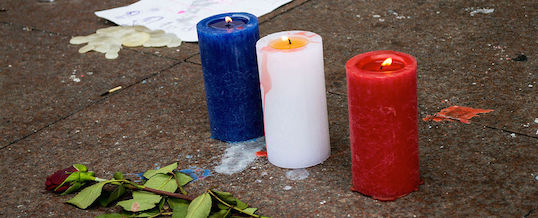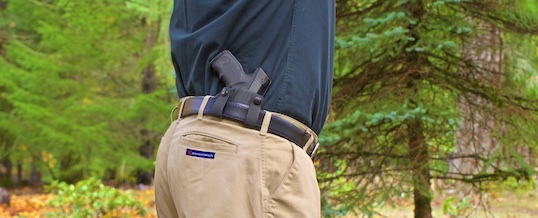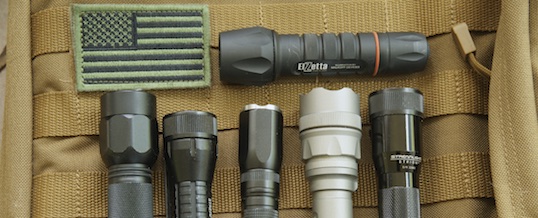
No, things really haven’t changed: self defense in a post-Paris world.
The bodies in Paris hadn’t even been buried when the agendas got trotted out. No, I’m not talking about gun control or immigration restrictions; I’m not talking about refugees or intelligence sharing or air strikes or border checkpoints, either.
I’m talking about the “you need to prepare to deal with this new threat!” brigade.
If you listen to them, the terrorist attacks in public spaces are such a unique and over-riding threat that you must simply develop a new skill set and carry different tools to deal with them. They’ll tell you that you need to consider a short-barreled, take-down rifle in a backpack, that you need to carry 5 spare extended magazines for your carry gun, and that you need to take a long-range handgunning class. ALL. RIGHT. NOW.
Let’s calm down a bit and get a little perspective on the issue. As Claude Werner points out in this excellent article, the risk of being involved in a terrorist incident is still quite small, even after Paris. In the scheme of things all of the other stuff we face every day — muggings, carjackings, home invasion robberies, auto accidents, house fires, swimming pool drownings, and all the other things that can hurt us — still have the same risk level they always have, and any one of them is substantially higher than being hit by ISIS (or ISIL, or whatever you want to call them.)
The reality of the situation is that the defensive tools and skills you needed two weeks ago are the same ones you need today. That’s not to say there isn’t a slightly higher risk of a mass casualty attack on American soil, only that you don’t need wholesale changes to how you carry, train and practice to be safe.
Let’s take the need for long range handgunning skills. I’ve said many times that a small portion of your training practice should be at longer ranges, say 25 yards or so. The data from Tom Givens at Rangemaster shows a fraction of real-life encounters happens at what we would consider extended distances, and so it’s a plausible skill to practice — as long as its in proportion to the likelihood of occurrence. Nothing in that recommendation has changed; you should spend a little bit of your practice time on shooting at longer distances, but not because Islamic terrorists might attack; rather, because some small number defensive shooting incidents always occur at those ranges.
As it happens, if you have solid defensive shooting skills and understand the basic concepts of shooting (like the balance of speed and precision), shooting at extended distances really isn’t a big deal. You’ll need to exert more control over the gun, which means you’ll need to slow down, which means you can’t shoot as quickly, but the mechanics really aren’t any different. It’s likely the only new thing you’ll learn is that when you get beyond about 150 feet (which is 50 yards) you’ll have to start compensating for bullet drop. Other than that, there’s no secret: the physical skills that you use to shoot to really silly levels of precision at 15 feet are the same skills you use to hit the torso of the target at 50 yards.
The only difference between those tasks is really psychological: the extended distance makes you think — believe — that it’s harder than it really is. The skills haven’t changed, only your perception of the skills you need to employ. When my classes have the space I like to set up a steel target at a little more than 50 yards away and have the students shoot it without any special preparation. I particularly like doing this in the revolver classes, as a lot of those students show up with snubnose revolvers like the S&W “J” frames. They’re convinced that hitting a target at such a “long” distance is impossible with a snubby or that they need some mystical voodoo techniques to do so.
Imagine their surprise when they ring the steel on their first or second shot, doing nothing but applying the skills they already have — and ignoring their doubting minds! This is something you can do on your range, assuming you have the distance of course. Apply the skills you have, ignore your inner critic, and control the gun. You’ll hit the target.
How often should you practice this kind of skill? I’d say, based on likelihood of use, around 5% of your defensive practice time/ammunition. Some might argue a little more or a little less, but I’d have to laugh at anyone who suggested devoting a quarter (or more) of your training resources.
What about carrying a rifle in a backpack? Isn’t that a necessity in a world where terrorists attack with AK-47s? I’ll ask you this: are you seriously going to carry that with you everywhere you go? Think about it; the kinds of events which might be a target for the kinds of attacks where a rifle would be useful are probably not the kind of events that will let you in with that backpack, or at least without checking it.
Leave it in the car just in case you need it? If it’s in the trunk it might as well be in Siberia when an attack happens — and you can forget the ride-to-the-rescue notions of running out of the mall, grabbing that rifle and running back in to save the day. That just isn’t a realistic scenario, if for no other reason than you look to both legally armed citizens inside the mall and responding police outside the mall like another terrorist. You’re probably going to get shot, if not by the attackers! (Not to mention the theft risk.)
What about the terrorist interdiction courses that are suddenly springing up to take advantage of the hysteria? Wouldn’t one of those be a good idea? Seriously, if you’re caught in the blast radius when someone sets off a bomb, no interdiction course in the world is going to help you. If you’re outside the radius (or merely injured) that trauma care course I’ve been urging you to take will be far more important than learning “bounding fire”.
Special terrorist response tactics? I’m not sure there are any, at least none that can be reasonably employed by an armed individual. The things you learn to deal with a shooter in a public space are the same regardless of their motivation, but have you ever felt a pressing need to take a “Lone Nutjob Interdiction Course”?
I know the world’s a scary place, and with the 24-hour news cycle and instant availability of on-scene video it seems scarier every day. The reality, though, is that the threats you face haven’t really changed much, and thus the skills you need to learn and practice really haven’t either. Resist the hype; don’t be lured by the hastily-conceived classes that promise to teach you “special” skills to deal with terrorist attacks. If you prepare properly and thoroughly for the incidents you’re most likely to face, those skills will still apply if you’re caught in a statistical outlier.
And take a deep breath now and again. It’ll do wonders for your perspective.
– Grant Cunningham
- Posted by Grant Cunningham
- On November 23, 2015



